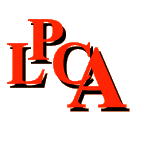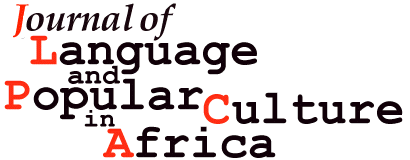

ISSN: 1570-016X





Volume 1 (2001) - Table of contents
Volume 2 (2002) - Table of contents
Volume 3 (2003) - Table of contents
Volume 4 (2005) - Table of contents
The Editors and how to contact them
The Journal of Language and Popular Culture in Africa is edited by:
Johannes Fabian
and
Vincent A. de Rooij
Before submitting manuscripts to the journal, please read the Editorial Policy and Guidelines to Contributors and How to submit. If you would like to know more about the editorial views on ownership and copyright of texts published at the LPCA web site, you may want to consult the section Texts and ownership.
For all other matters pertaining to the journal, please contact the editor in charge, Vincent A. de Rooij.
The editors can also be reached by regular mail, by telephone, or by fax:
Vincent A. de Rooij, Editor in Charge
Journal of Language and Popular Culture in Africa
Department of Sociology and Anthropology
University of Amsterdam
O.Z. Achterburgwal 185
1012 DK Amsterdam
The Netherlands
Telephone: +31 20 525
2615
Fax: +31 20 525 3010
E-mail:<vderooij@pscw.uva.nl>
Editorial Policy and Guidelines to Contributors
Studies published in the Journal of Language and Popular Culture in Africa document and describe, but also analyze materials from text collections available at this site or elsewhere. The kind of contributors we have in mind come from a wide range of disciplines, including anthropology, sociology, African history, literary studies, philosophy, (socio-)linguistics.
Contributions to JLPCA will generally consist of densely annotated texts followed by a detailed analysis of the data presented (see the description below). Other kinds of manuscripts will be published in JLPCA as well. Priya Narismulu's article in the first issue of JLPCA is an example of an article that discusses a wide range of poetic works from which numerous fragments are presented.
Presentation of Popular Texts
Publishing popular texts raises the question of how to present, or rather, represent these texts to the reader. Problems of representing oral texts have been discussed extensively over the past decade. Most scholars working with oral texts have come to realize that transcribing oral texts is interpretative in nature and always informed by theoretical assumptions. The editors of the Journal of Language and Popular Culture in Africa, therefore, expect contributors to the series to address this issue. The editors realize that transcription systems and conventions may differ from one contributor to another. This is not considered problematic as long as contributors strictly adhere to their conventions and provided that the system applied does not interrupt the flow of reading in a serious way.
Written texts, especially handwritten ones, present problems resembling those encountered in transcribing. It is impossible to retain the exact appearance of a handwritten text when transforming it into a printed form. Therefore, some degree of editing (standardizing margins, adding punctuation marks, standardizing spelling, marking illegible or ambiguous letters or words1) will always be necessary. Contributors will have to be explicit about, and comment on the editing process. By means of a photo of a fragment of the handwritten text, they may show how the physical shape of the original text differs from the edited, printed, version.
Translation
Although some of the first issues of the Journal of Language and Popular Culture in Africa will be of interest primarily to students of Swahiliphone societies, most, if not all, of whom will be able to read (some variety of) Swahili, the documents and texts published in the series will be accompanied by a parallel English translation for the following two reasons. First, the texts that will be published in the first issues of the Journal of Language and Popular Culture in Africa will be in rather distinct varieties of Swahili that differ from each other in phonology, morpho-syntax, lexical semantics (including idioms), and lexicon in general, due to contact with English, French, and locally spoken languages. Therefore, readers who are not familiar with the variety of a particular text would encounter serious problems of interpretation if an English translation were missing. Second, the texts to be published in the Journal of Language and Popular Culture in Africa should be accessible to scholars working outside Swahiliphone areas, with a general interest in popular culture, folk literacy, language contact (code-switching, borrowing, pidginization and creolization), stylistic variation, and oral literature.
It is felt that the translations accompanying the texts should be literal rather than free. That is to say, the translator should try to stick to the original as closely as possible. The meaning of idioms and highly culture-specific lexical items may be commented on in footnotes. In order to maintain the integrity of the text, an interlinear translation is ruled out as a possible format. Instead, the translation should appear in a column or page parallel to the one of the text. The lines of the original and the translation should be numbered for ease of reference. This format does not allow for giving supplementary information in the form of lines containing morpheme by morpheme glosses and/or suprasegmentals and/or para-linguistic information and/or other commentary. Suprasegmentals may be marked within the transcript by making use of special graphic symbols, while para-linguistic information may be given between brackets. Comments on specific (con)textual features should be in the form of footnotes. If authors have interlinear glosses, or other interlinear information, available, they have the opportunity to supply these in a separate file. This rich file, then, contains texts plus any number of interlinear lines.
Contextualization
Texts should be preceded by a general introduction in which the author should at least address the following questions. When, where, by whom, and how was the text produced? In other words, the author will have to describe the context of production of the text. In the case of written texts, s/he will also have to comment on whether and how s/he edited the text, while in the case of oral texts procedures and conventions of transcribing have to be described. It is also expected of the author that s/he will comment on the physical features of the text (in the case of written texts) and on the structural characteristics of the variety used.
The editors of the Journal of Language and Popular Culture in Africa realize, of course, that the contributors have widely diverging disciplinary competences. It is inevitable, therefore, that the authors will emphasize different problems and issues in their introductions. As long as the basic requirements of the introduction are met (contextualizing the text and describing physical and structural features of it), the authors are free to expand on any topic or issue they feel is important deserves comment. Ideally, Introductions should not exceed 15 pp.
Analysis
The main aim of the Journal of Language and Popular Culture in Africa is to document the popular culture expressed in, and mediated by, popular, vernacular, varieties of African languages. However, authors are invited to contribute analyses of the published texts. The editors grant the authors absolute freedom in matters of format and type of analysis. The authors have to keep in mind, however, that the analysis should be aimed at helping the reader gain a better appreciation and understanding of the text. The length of the analysis (in number of pages) should, preferably, not exceed 30-40 pp., i.e. the size of an major article.
Authorship
Publishing written and oral popular texts raises the question of who should feature as the author on the title page.
Buntungu's "Mokingi mwa Mputu": A Boloki perception of Europe at the end of the 19th Century
We should hasten to add that the above is not be read as a definitive statement on this issue, if only because the conditions under which texts and meta-texts are produced vary widely. Any comments on our current position are welcome. Proposed Format Each volume in the series consists of Text and Translation, preceded by an Introduction, and followed (optionally) by an Analysis: The publication may be accompanied by a rich file containing the text and all additional information (interlinear glosses, suprasegmentals, paralinguistic information) the author is willing to supply.
Article:
Contribution to edited volume:
Book:
Online resources:
last updated: 18 November 2005
It is clear that s/he whose speech was recorded and whose writings were collected should be identified as the author.
However, there is also the author of the Introduction, Transcription (in the case of oral texts), Edited Text (in the case of written texts), Translation, and the Analysis who also provides textual commentary in the form of footnotes. It is this person who assumes final responsibility not only for the form and format in which the text is published, but for the meta-textual context (notes, interpretation, translation) in which the text is presented as well. For reasons of clarity, we shall refer to this person as author/editor.
In order to signal these different kinds of authorship to the reader, we propose to include the name of the person whose speech was recorded and whose writings were collected in the title, while the name of the author/editor is given separately in order to underscore her/his responsibility for the form in which the text is published. Depending on the preferences of the author/editor, the name of the author/editor may be preceded by edited by or presented by. This title page format was used for Michael Meeuwis' contribution to the LPCA Text Archives:
presented by
Michael Meeuwis
<http://www.lpca.socsci.uva.nl/textarchives/buntungu.html>
Our views on issues of ownership and copyright of texts published at the LPCA web site are dealt with in more detail in Text and ownership.How to submit
If you have any further questions about how to submit your MS to JLPCA, do not hesitate to contact the editor in charge.
Bibliographical references should conform to the following format:
Blommaert, Jan. (1995). 'A Shaba Swahili life history: text and translation.'
Afrikanistische Arbeitspapiere 42: 73-103.
De Rooij, Vincent A. (1997). 'Shaba Swahili: Partial creolization due
to second language learning and substrate pressure.' In Arthur K. Spears
and Donald Winford (eds.), The structure and status of pidgins and
creoles. Amsterdam: John Benjamins. 179-190.
Fabian, Johannes. (1998). Moments of freedom: Anthropology and popular
culture. Charlottesville: University Press of Virginia.
Please follow the guidelines offered by the Columbia Guide to Online Style.
by Vincent de Rooij